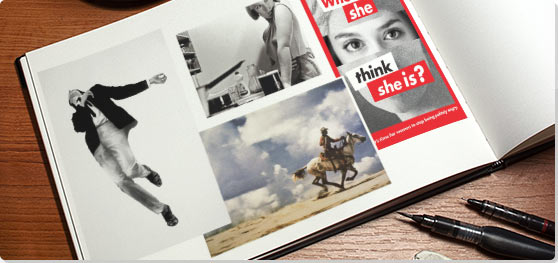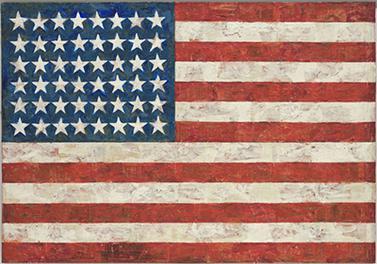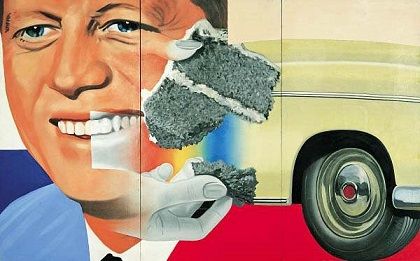Summary of The Pictures Generation
The Pictures Generation was a loose affiliation of artists, influenced by Conceptual and Pop Art, who utilized appropriation and montage to reveal the constructed nature of images. Experimenting with a variety of media, including photography and film, their works exposed cultural tropes and stereotypes in popular imagery. By reworking well-known images, their art challenged notions of individuality and authorship, making the movement an important part of postmodernism. The artists created a more savvy and critical viewing culture, while also expanding notions of art to include social criticism for a new generation of viewers saturated by mass media.
Key Ideas & Accomplishments
- Influenced by the ubiquity of advertising and the highly saturated image culture of the United States, Pictures Generation artists produced work that itself often resembles advertising. In thus challenging traditional art forms that appear handcrafted, these artists situated themselves at the center of postmodern debates about authenticity and authorship while in the process creating art that is slick and has the appearance of mass production. Their works blur the lines between high art and popular imagery.
- Though many artists in the group were trained formally in traditional disciplines such as painting and sculpture, they elected to utilize their skills in unorthodox ways - re-examining composition, particularly within popular image production. The ready availability of cameras allowed artists to reconsider photography's stance as an artistic medium, composing images with conceptual frameworks.
- Like photography, video is the perfect medium through which to explore the blurry boundaries between originals and reproductions. The advent of the portable video camera along with the first examples of video art in the 1960s allowed Pictures Generation artists to analyze and critique television for the first time.
- Members of Pictures Generation were given impetus by Roland Barthes’s most important essay, "The Death of the Author" (1967). The Frenchman did more than any other to initiate the age of Poststructuralism (the philosophical companion of postmodernism) by challenging the idea that what an author/artist said about their art was the definitive word on its meaning. His essay gave legitimacy to the idea that "truths" (plural) should replace "truth" (singular). By reworking (or even just copying) existing imagery, Pictures artists were asking the viewer to question (like Barthes had) the two great cornerstones of modernist ideology: authenticity and artistic genius.
Artworks and Artists of The Pictures Generation
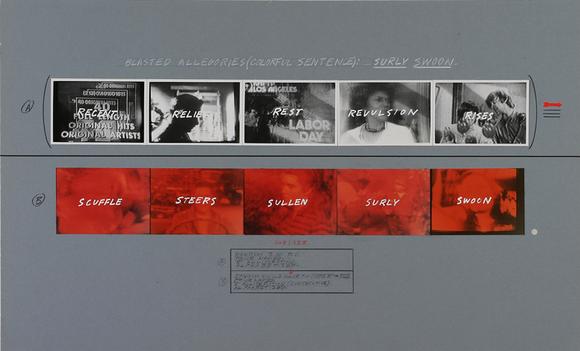
Blasted Allegories(Colorful Sentence): Surly Swoon
John Baldessari began his artistic education in San Diego and began introducing text and photographs into his paintings during the late 1950s. By the 1970s he had expanded his practice to include sculpture, film, installation, and printmaking. Like others of the Pictures Generation, Baldessari read newly available critical texts extensively, incorporating the theories of structuralist Claude Levi-Strauss into his artwork, particularly in the photomontage series Blasted Allegories. For Blasted Allegories, Baldessari arranged a series of photographs on a board to organize images as one would words in a sentence, playing with syntax and rhyme, destabilizing models of construction visually and linguistically. The stills depict various objects, stills from films and television, and bits of pop cultural ephemera. His work is humorous, juxtaposing visual jokes with seemingly straightforward text to obfuscate direct meaning. The words are relevant to the image shown, but when strung together with other sentences, they are not fully coherent. Through the prescribed images and text, the viewer acts as an active reader, scanning the visual and verbal sentence through the physical line, deriving his or her own sense of the work through various readings of the arrangement. The viewer is thus situated as an active producer of the work's meaning, questioning traditional notions of authorship and creativity.
Photographs on board - Ron L. Feigen & Co., New York
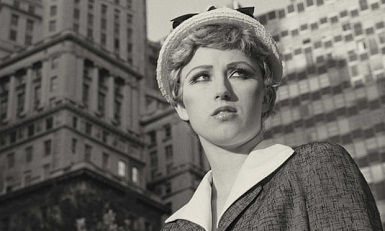
Untitled Film Still #21
For Untitled Film Stills series, Cindy Sherman began photographing herself staged in various scenes that appeared to be from classical Hollywood films: a girl arriving in the big city, a girl cooking over the stove, a girl in lingerie dressing herself. The stills seem recognizable, but are taken from no particular movie, mimicking typical cinematic angles, lighting, and dramatization to convey a sense of the familiar. Critics have commented on Sherman's representation of females as "making strange" - forcing the viewer to be a more critical observer of the constructed re-representation, categorizing Sherman's work as a feminist intervention. Sherman draws attention to the fact that a woman's appearance is often associated with her identity: a woman is valued in society to be looked at. The film theorist Laura Mulvey established the term "male gaze" to illustrate the typical perspective of a filmgoer, who assumes the role of male subject. Taking the term from psychoanalysis, Mulvey surmised that vision works as a function of sexual and developmental drives, and male-directed films of the mid-20th century often served to place women in subjugated roles, relegating women to fetishized victims or villainous femmes fatales who were unable to be agents of their own destiny. Sherman's reworking of these archetypes, as creator and character, interrupts the male gaze and re-establishes the women in the photographs as agents, while simultaneously complicating the relationship as she freezes herself in these multiple roles.
Gelatin silver print - The Metropolitan Museum of Art, New York
Men in the Cities
One of Longo's most well known series is Men in the Cities, a group of charcoal drawings that depicts various individuals frozen in exaggerated movements. The people are dressed in business garb, suits, jackets, ties, prim dresses, and heels, thrusting and careening wildly. The critic Craig Owens points out the "aestheticization of violence" within Longo's practice, as he freezes these ecstatic figures in moments of frenzy. There is a disparity, however, between the conservative attire and the jerky motions that renders these images somewhat mysterious and awkward. The men and women are still but convey kinetic movement in their positions, suggesting movement beyond the white background, beyond the frame. In the 1980s, as Ronald Reagan-era politics became synonymous with big business concerns and corporate branding, artists investigated how identities were being divorced from individuals, enforcing a type of alienation. Longo studied sculpture and he slyly insinuates three-dimensionality through suspension, hitting pause to question how citizens are complicit in the society in which they participate despite an adherence to so-called proper appearances.
Charcoal & graphite on paper - Vanmoerkerke Collection, Belgium
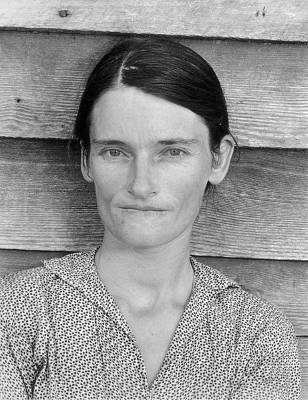
After Walker Evans: 4
Levine produced a series of photographs in 1981 by re-photographing reproductions of Walker Evans' photographs from the Great Depression that were printed in catalogues. The gesture of re-photographing the famous images re-positioned the author, the viewer, and the subject. Levine more than merely reproduces the already reproduced photograph. By inserting herself as the author, she complicates the original intent of the image and exposes the power structures inherent in image production. The narratives of art history, which Evans has contributed to through his own photographic practice and subsequent fame, are often written by male authorities and feature mostly male artists. With After Walker Evans, Levine intervenes and re-writes the narrative, forcing the viewer to question how one creates meaning and history, and what is considered natural in the composition of a photograph. Additionally, Levine's appropriation of the image from a catalogue image speaks to how artwork is commodified and rendered authorless through reproductions and varied methods of circulation, echoing the theorist Walter Benjamin's concerns regarding "the work of art in the age of mechanical reproduction."
Gelatin silver print - The Metropolitan Museum of Art, New York
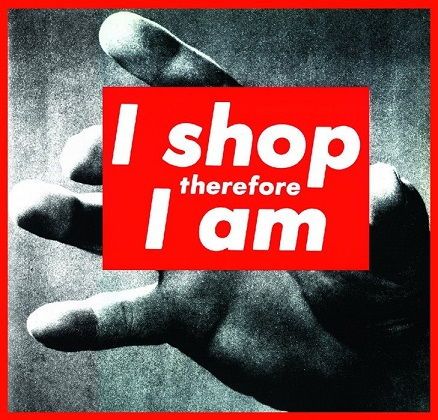
Untitled (I Shop Therefore I Am)
Kruger began her career in advertising - specifically, working in graphic design and layout at Conde Nast - and the juxtaposition of image and text in her work often speaks to her former training. In Untitled (I Shop Therefore I Am) two fingers hold a palm-sized card outward. The card itself is wiped of its original face, as Kruger has clearly set "I shop therefore I am" across the flat red surface. The viewer can probably deduce that the original image displayed a credit card, tying the new text to its appropriation. The statement "I shop therefore I am" links the excitement of sponsored consumerism and constructed female identity. As popular formats like films, ladies' magazines, and department store advertisements dictate what is appropriately feminine and desirable, Kruger ironically turns the upbeat slogan against itself by displacing image from attractive arrangement. The interruption of bold text and bright crimson stop the viewer, forcing them to ask what representation and identity mean for women in a consumer society, and how advertising tries to shape this identity.
Photographic silkscreen & vinyl - Mary Boone Gallery, New York
Untitled (Cowboy)
At first glance, one sees a seemingly romantic all-American image of a Stetson-topped cowboy against a brilliant blue expanse of mountain and sky in Richard Prince's Untitled (Cowboy). However, the photograph is grainy, somewhat unclear, an incomplete, imperfect image. Prince appropriated it from an advertisement for Marlboro cigarettes, instead re-photographing and distorting a page torn from a glossy magazine to track the construction of an American symbol: the Marlboro Man. In the beginning of his career, Prince worked in a New York publishing company collecting and sending physical pages from magazines to advertisers to prove that they were run in magazines. He began to photograph a series using the Marlboro Man advertisements, eliminating the text, cropping and blurring the existing image, and producing alternative meaning. Although the Western archetype of a cowboy has been long associated with an American masculine ideal, Prince disrupts the highly polished and constructed image by removing its context, reminding the viewer that mythic ideals inform consumer habits and that the viewer is complicit in the creation of that myth.
Ektacolor print - The Museum of Contemporary Art, Los Angeles
Mining the Museum
Fred Wilson's work focuses on institutional bias and derives from the work of earlier Conceptual artists such as Hans Haacke and Marcel Broodthaers. His works criticize arts institutions and reveal larger issues surrounding the social function of art as a mass-media influence. In this work at the Maryland Historical Society, Wilson rearranges pieces of the collection to highlight overlooked aspects of Maryland's history. For example, in a display of teapots and other ornate silver pieces, Wilson inserts a pair of slave shackles that were made in the same time period. Their inclusion upsets the traditional distinction between arts and crafts while also highlights the white European vantage point of the museum's exhibition, which attempts to whitewash Maryland history.
Technology/Transformation: Wonder Woman
Birnbaum is one of the best-known Pictures Generation artists to work in video, specifically critiquing television. Her Technology/Transformation: Wonder Woman examines the paradoxes implicit in the 1970s "Wonder Woman" television program by cutting up scenes from the show and reposing a disco song about the superhero. In the video, bursts of fire, meant to suggest the deconstruction of ideologies in television, open the piece. Birnbaum repeats TV sequences when character Diana Prince transforms into Wonder Woman, making the superhero appear as a wobbly music-box figurine, without her supposed strength. The lyrics from the 1978 song "Wonder Woman in Discoland" also play across the screen, further undermining the character by underscoring the sexual source of Wonder Woman's "empowerment."
Beginnings of The Pictures Generation
Reconsidering Photography and Film
The artists who would be involved in the Pictures Generation grew up in the 1960s when consumerism and mass media began to have a large impact on society. They were the first generation of artists raised with television.
In the 1970s and 1980s conceptual art ideas were being circulated through art professors who began to incorporate then-unorthodox and nontraditional media into their curricula. Many artists abandoned conventional educational tracks in painting and sculpture, recognizing the influence of mass-media formats such as advertising, film, and video, and brought representation into conceptual art practice instead. Programs like the Whitney Independent Study Program in New York City, which was established in 1968, the visual arts program at New York's Buffalo State College, and the California Institute of the Arts (CalArts) in Los Angeles were cutting edge curricular innovations. A majority of the artists of the Pictures Generation studied in Buffalo, New York or Los Angeles.
East Coast
Several of the Pictures Generation artists studied at Buffalo State College, including Robert Longo, Charles Clough, and Cindy Sherman. Professors like photographer introduced them to Conceptual art and students were encouraged to be independent-minded and to experiment. While still undergraduates, the aforementioned artists founded Hallwalls in 1974 as an alternative art space in downtown Buffalo where their studios were located. The space was intended to show cutting edge photography, performance, and film not funded by corporate interests. Using student activities funds, they also set up a visiting artists program and invited prominent artists like Sol LeWitt, Vito Acconci, Richard Serra, and Philip Glass, among others. In the late 1970s some of their work was also being shown at Artists Space in New York City. Other artists in the Pictures Generation who had studied, and/or were working in New York City by the mid 1970s include Barbara Kruger, Richard Prince, Louise Lawler, and Laurie Simmons.
West Coast
Developments in postmodern art practice were brewing on the west coast, as well. The photo-conceptualist John Baldessari began teaching a visual arts program at CalArts in 1970, the same year he burned all of his previous paintings. Though initially hired as a painter, Baldessari taught a class titled "Post Studio," broadening artistic understanding of studio practice. In addition to giving students access to contemporary art from America and Europe, Baldessari introduced film, video, photography, and advertisements to the curriculum. His focus on photography and montage were key elements that his students would eventually manipulate in their own art: David Salle's disjunctive paintings, for example, show the influence of film and photography. At CalArts, Baldessari taught , James Welling, Jack Goldstein, Matt Mullican, and Troy Brauntuch, in addition to Salle. Many of these artists decamped for New York in the mid-1970s and were dubbed the "CalArts mafia," in part for their brashness.
East and West Meet in New York City
An important figure tying these two coastal groups together was Helene Winer, director of the Pomona College Museum of Art in Claremont, California from 1970 to 1972 where she showed artworks by Baldessari and others from CalArts. In 1975 Winer became the director of Artists Space in New York City where she exhibited the work of Cindy Sherman, among others. All of the artists in Winer's circle - both from California and New York - circulated in the same social milieu, lived in close proximity to each other, and/or bonded through various day jobs and art-related activities. Cindy Sherman, for example, was the receptionist at Artists Space and dated Robert Longo while Jack Goldstein, who attended CalArts, was Winer's boyfriend. Art critics who wrote about the Pictures Generations artists - Douglas Crimp, Brian Wallis, and Craig Owens - were also part of their social group, attending the same parties and nightlife spots.
It was Winer who encouraged Crimp to organize the "Pictures" show in 1977 at Artists Space, from which the movement gets its name. The show then traveled to the Allen Art Museum at Oberlin College in Ohio, the Los Angeles Institute of Contemporary Art, and the University of Colorado Museum in Boulder. It featured the work of five artists: Troy Brauntuch, Jack Goldstein, Sherrie Levine, Robert Longo, and Philip Smith.
While the show itself did not make much of a splash, in 1979, Crimp republished the accompanying exhibition text in the art journal October where he expounded upon the themes implicit in "Pictures," discussing more artists than were included in the exhibit. Pictures Generation artists also contributed to the burgeoning discourse circulating in art journals and magazines. Cindy Sherman, for example, was commissioned by Artforum to create "centerfold" portraits for the magazine in the 1980s, and Barbara Kruger pursued art criticism on top of her visual practice.
The Pictures Generation: Concepts, Styles, and Trends
Appropriation
Building on the work of Neo-Dada and Pop artists, artists of the Pictures Generation appropriated existing images and re-contextualized them to undermine their original intent. Whereas Pop playfully poked at and surveyed design-conscious image production, Pictures artists more typically appropriated images to question and criticize the inherent power structures in mass-circulated imagery. Dara Birnbaum's video work, for example, manipulated scenes from television to uncover stereotypes in the medium. Because of the interest in appropriation and its refusal of traditional art hierarchies, the Pictures Generation is considered an important movement within postmodernism.
Poststructuralism
The famous French essayist, Roland Barthes, affected something of a revolution in cultural theory with the publication of his 1967 essay "The Death of the Author". He was able to "subvert the structures of language" – hence "post"-structuralism - by proclaiming the author's death. Despite its many gray areas and flaws (the likes of Sherman, Kruger, Prince and Levine attest to the fact that the author clearly did not "die", neither metaphorically nor physically), the idea that there was no wrong way of reading a text, and that meaning resides with the reader of the text (its destination) rather than with the author/maker of the text (its origin) brought about a sort of semantic role-reversal that proved hugely influential within the field of cultural studies. The belief that there was no such thing as authenticity in art was perfectly in step with the dawning of the age of postmodernism.
Authorship and the Viewer
Tied closely to the use of appropriation, the work of Pictures Generation artists questioned traditional notions of authorship. Sherrie Levine's work, for example, in appropriating the photographs of other artists, questions ideas of originality. Many Pictures Generation works also rely on the viewer to produce their meanings, further eroding the conventional significance of the artist as creator. Barbara Kruger's works often include the pronouns "I" or "you" that directly address the viewer, challenging them to critically assess how their lives are affected by media. The viewer is challenged to create meaning in David Salle's paintings where he juxtaposes disparate images in vertical registers that mimic film.
Advertising and Identity
Many artists of the Pictures Generation worked to reveal biases innate in popular advertising and other imagery. Artists such as Barbara Kruger and Richard Prince, who both had backgrounds in advertising, manipulated imagery to show how marketing executives were shaping consumers expectations and buying practices. Others such as Matt Mullican, not specifically focused on advertising, explored how humans create and maintain their identity or sense of reality through their subconscious.
Gender
There were several Pictures artists whose work displayed concerns with gender disparity and objected to the patriarchal narratives of popular media and art history. Instead of celebrating characteristics thought to be intrinsic to women (essentialism), Pictures artists turned to developments in psychoanalytic theory as well as film theory, both of which claimed the cultural perspective of the viewer as dominantly male, privileging one gender over another. In works by Kruger and Sherman, for example, deconstructed and appropriated images displayed the disparity between individual agency and expectations that stemmed from social construction of femininity. Collectives such as the Guerrilla Girls, working in the late 1980s and early 1990s, would utilize more obvious, rebellious, and often humorous tactics, pasting giant advertising plaques to force public attention toward the gender inequalities of the art world. Paul McMahon also used humor and kitsch in his Postcard Fan (Girl in a Bathing Suit) from 1975 to underscore the ubiquity of the female body in advertising.
Race
Inherent racism in popular media and art institutions was also a recurring theme in the work of some Pictures Generation artists. and Carrie Mae Weems (both of African-American descent), whose bodies of work began to develop at the end of the Pictures' years, both explored blackness and femininity, utilizing photography and text to activate different readings for the viewer. Fred Wilson's work focused on how African-American history, particularly slavery, is glossed over by museums.
Later Developments - After The Pictures Generation
The original five artists included in Crimp's 1977 "Pictures" exhibition were never a formal group and did not exhibit together again. However, Crimp's 1979 essay in October gave prominence to the themes and methods of their work, leading to numerous exhibits throughout the 1980s that showcased a revolving array of artists such as Sherrie Levine, Barbara Kruger, and Richard Prince whose works were thematically similar. These artists are now considered part of the Pictures Generation.
By the end of the 1980s blockbuster exhibitions such as the "Forest of Signs" (1989) at the Museum of Contemporary Art, Los Angeles and the "Image World" (1989) at the Whitney Museum of American Art in New York explored ideas comparable to those of the original "Pictures" show while further expanding the roster of artists to include younger individuals like Mike Kelley.
Cementing a continuing influence on contemporary art, many of the artists were brought together again in 2009 at an exhibit at New York's Metropolitan Museum of Art entitled "Pictures Generation, 1974-1984." The show firmly placed the thematic group within a trajectory of postmodern conceptual artistic practice that began with Robert Rauschenberg.
Contemporary artists continue to address those themes significant to the Pictures Generation artists. Gary Simons, represented by Metro Pictures, does wall drawings in chalk as well as sculpture that deal with issues of race and gender within popular culture. Clare Fontaine, a French artist who works in neon, focuses on the intersection of the political and the popular. Among the many others that create works along these lines including Andreas Slominski, Annette Lemieux, Olaf Breuning, and Andreas Hofer.
 Ask The Art Story AI
Ask The Art Story AI